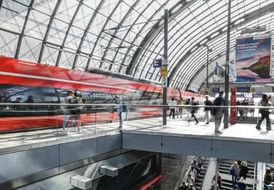Greenhouse gas intensity
The share of renewable energies in the DB traction current mix in Germany is not the only measure by which we manage our progress in climate protection. We also track the development of our specific greenhouse gas emissions in comparison to 2006.
Specific CO₂e emissions in comparison to 2006 / % | 2022 | 2021 | 2020 |
DB Group | –42.1 | –36.1 | ‒34.4 |
Since 2021, excluding DB Arriva.
Excluding fleet vehicles, DB Schenker stationary divisions, DB Arriva and individual divisions of DB Cargo.
As part of our DB Group climate protection target, in 2022, we were able to further reduce specific greenhouse gas emissions and are therefore significantly ahead of our forecast from the 2021 Integrated Report. This is due, among other things, to the stronger-than-expected increase in the number of passengers as a result of the rapid recovery in demand. Our absolute greenhouse gas emissions. fell in 2022 and are around 2 million t below the pre-Covid-19 value. In particular, the increased implementation of efficiency and reduction measures in the wake of the energy crisis led to significant energy savings in some cases.
Specific CO₂e emissions from DB Group journeys and transport by mode of transport | 2022 | 2021 | Change | 2020 | |
absolute | % | ||||
Regional rail passenger transport (g/pkm) | 46.9 | 76.5 | –29.6 | –38.7 | 72.6 |
in Germany | 44.9 | 74.1 | –29.2 | –39.4 | 67.9 |
Long-distance rail passenger transport (g/pkm) | 0.9 | 1.4 | –0.5 | –35.7 | 1.5 |
Bus transport (g/pkm) | 75.5 | 100.4 | –24.9 | –24.8 | 105.6 |
in Germany | 110.5 | 117.2 | –6.7 | –5.7 | 123.1 |
Rail freight transport (g/tkm) 1) | 15.9 | 17.2 | –1.3 | –7.6 | 17.0 |
in Germany | 14.5 | 16.2 | –1.7 | –10.5 | 16.3 |
Road freight transport (g/tkm) 2) | 80.6 | 82.0 | –1.4 | –1.7 | 87.3 |
Air freight (g/tkm) 3) | 666.9 | 657.3 | +9.6 | +1.5 | 669.5 |
Ocean freight (g/tkm) 3) | 5.7 | 5.5 | +0.2 | +3.6 | 5.6 |
Well-to-wheel (WTW); Scopes 1 –3; rail transport companies are considered with their own electricity mix or European country mixes.
1) Up to and including 2020, excluding rail freight transport from/to China by DB Cargo and DB Schenker. Double accounting may be included in 2021, meaning that the values may be slightly higher.
2) Up to and including 2020, excluding pre-carriage and onward carriage from land, air and ocean freight.
3) Since 2021, excluding pre-carriage and onward carriage.
In order to further reduce our greenhouse gas emissions, we are focusing on phasing out fossil fuels. In addition to testing new battery-operated vehicles and converting existing vehicles to hydrogen drives, we are also pushing ahead with the rollout of bio fuels. We rely, among other sources, on the biofuel hydrotreated vegetable oil (HVO), which is produced from biomass-based residues and waste materials and is therefore not in competition with food and feed production. In addition, it is important to us that the fuel used is free from palm oil and palm fatty acid distillates. DB Long-Distance has set a target of a complete conversion from fossil fuels to HVO by 2025. HVO has been approved for the entire DB Cargo Germany diesel locomotive fleet since mid-2022. DB Cargo UK already runs part of its transport services on HVO.
We are also accelerating the heat transition. In the long term, heating supply is also to be climate-neutral and fossil energy sources such as heating oil and natural gas are to be gradually replaced. Oil heating systems are no longer directly replaced at the end of their life cycle, but instead are replaced by efficient alternatives that support climate neutrality, such as heat pumps or biomass systems. New energy supply concepts were created for the top 50 DB Group sites in Germany in 2022. The locations are now gradually being re-equipped.


